The basics of growing cannabis outdoors
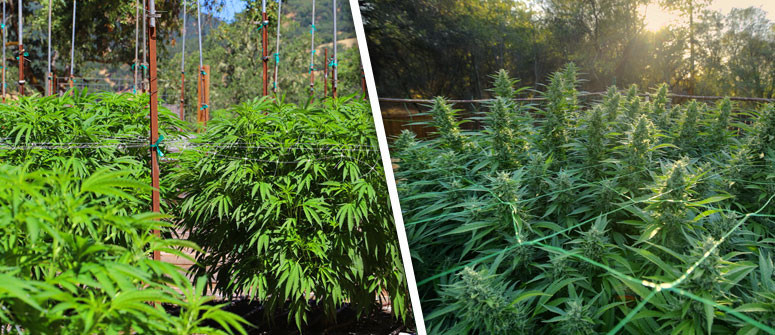
Growing cannabis outdoors comes with its challenges, but it's also very rewarding. Use this beginner's guide to achieve huge yields of healthy bud!
Growing cannabis outdoors is a whole different experience than cultivating the herb within the comfort of an indoor setting. Growing indoors involves recreating a natural environment, and gives the grower control over pretty much every variable from temperature to humidity to lighting. Growing outdoors is a different animal altogether. Plants are exposed to the elements, heat and humidity cannot be controlled, and pests pose a far bigger threat.
Despite some of these potential difficulties, growing outdoors is an extremely rewarding process. Tending to your plants while the early morning mist skates across the dew-heavy grass is a magical moment, and inspecting leaves and flowers whilst the golden glow of sunset strokes the foliage is something that just isn’t possible indoors. Furthermore, if growing in beds, plants have the opportunity to spread their roots, grow to much larger sizes, and generate mammoth yields in comparison to their indoor counterparts.
Before you initiate your outdoor operation, there are several factors you need to consider to ensure success. Below is a list of the basic components of growing cannabis outdoors, designed to give you the best start possible.
DO YOU LIVE IN A SUITABLE LOCATION?
Before endeavoring to cultivate cannabis outdoors, it’s important to consider if your location is suitable. For one, if you live in an urban or suburban setting in a region that doesn’t tolerate cannabis, you might be far better off cultivating indoors for the sake of discretion.
TEMPERATURE IS A FUNDAMENTAL FACTOR
Location is also a vital factor to consider due to cannabis’ environmental demands. Cannabis is an extremely versatile and adaptive plant found thriving in nature all around the world, from the tropical heat of the equator all the way to the bitter climates of Central Asia. Chances are, your location is suitable for cannabis cultivation—but the herb simply won’t perform as well in extremes.
Sustained temperatures of 30°C or higher will cause plant growth to slow down or stop entirely, whereas temperatures below 12°C will contribute to a decline in plant health and can even be fatal. Make sure your region remains comfortably within this range before sowing a crop.
It’s important to realize different strains grow better in different climates, something we’ll cover later on.
LOCATION ALSO DETERMINES LIGHT EXPOSURE
Another factor that falls into the category of location is latitude, a geographical coordinate that specifies the north-south position of a point on Earth. Latitude is important because it dictates daily light exposure across the growing season. The hours of light a plant receives during the day is vital for two reasons. Reason one is that plants require light to perform the crucial process of photosynthesis, in which they convert sunlight to fuel in the form of glucose. Reason two is that photoperiod strains require a seasonal shift in light cycle to let them know that autumn is approaching and that it’s time to flower. Understanding what latitude your location sits at will help you know just how much light your plants will receive each day of the season, and when they are likely to begin flowering.
CHOOSE A SPOT WITH MAXIMUM SUNLIGHT AND A GOOD BREEZE
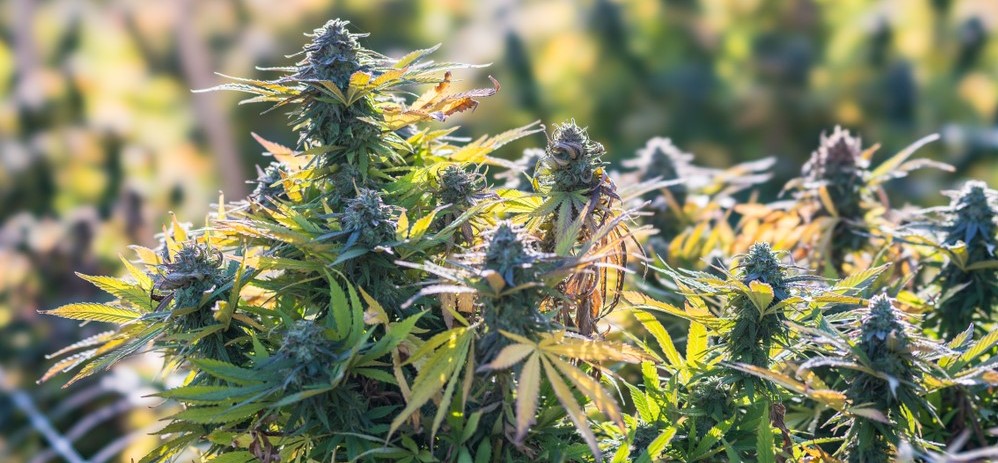
Try and find a spot in your garden that receives as much sunlight as possible. The more your plants can photosynthesize, the more fuel they will create to grow and provide superior yields. If you live in an area where the sun can be particularly brutal during the mid-summer, keep an eye on plant hydration.
Placing your plants in a spot that's exposed to the breeze will also help them become stronger and more capable of carrying the weight of their own buds later down the line. Plants adapt to a constant light breeze by becoming more sturdy, especially at a younger age. If your location is predisposed to gale-force winds, then consider temporary windbreaks, or position plants safely next to walls and other forms of shelter.
NATURE IS IN CONTROL: KNOW WHEN TO GROW
Indoor growers have the luxury of setting up a grow whatever time of year they see fit. One of the limitations of outdoor growing is that nature is in control, and when she decides it's too cold for plants to survive, then it’s too cold.
Growing outdoors requires the virtue of patience. There is a window in the year, the growing season, in which growers must germinate seeds, rear them through the vegetative and flowering phases, and harvest them. Growers fortunate enough to live in the tropics can grow cannabis all year round, but those living much further north must obey these natural rhythms.
To get a head-start and extend the growing season, it is possible to start plants indoors, where they will be safe from potential frost, and then transplant them outdoors further down the line. It should be possible to have your plants in the ground around May in most areas of Europe and the United States. Check out the recommended sowing times for leafy greens in your region for a rough estimate. Harvest time usually occurs around September or October, but this greatly depends on the flowering time and characteristics of a particular strain.
USE THESE FACTORS TO DECIDE WHICH CANNABIS GENETICS TO USE
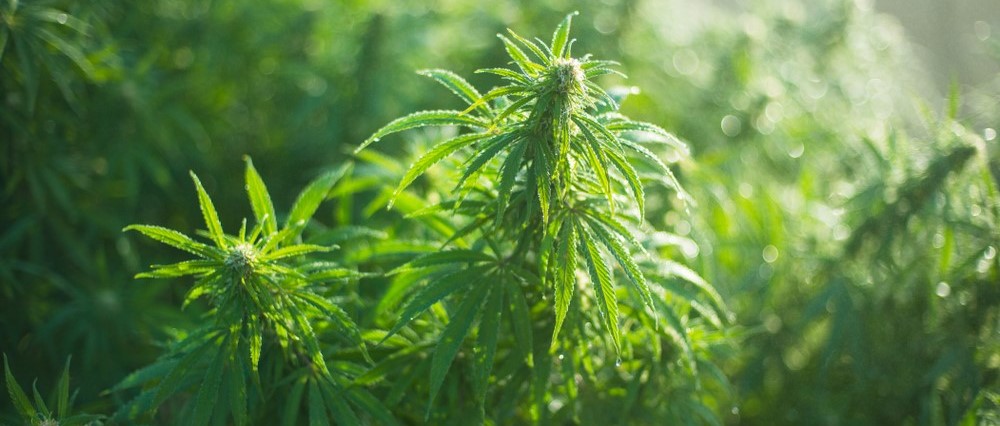
Cannabis is a crop that is loved all over the world. Its exposure to an array of different environmental factors, and to many different breeders with varying desires, has resulted in the selective breeding of a massive amount of cultivars. Thousands of strains exist, each with different growing traits, tastes, and effects.
Growers who live in mild and forgiving climates are fortunate enough to be able to grow almost any strain they want, whereas those living in areas with shorter growing seasons and colder weather are limited to hardy, fast-flowering strains.
The strain you select should be aligned with the outcomes that you’re after. If your main goal is to receive a titanic yield, then it’s worth selecting a towering sativa variety that can easily exceed a height of 3m and put out a yield in the domain of kilograms. If your goal is to raise plants that offer a soothing, stoning, and relaxing effect, then a pure indica or indica-dominant hybrid will be suitable. Some strains have also been bred to specifically thrive outdoors.
If you live in a harsher climate with less seasonal light exposure, or simply want to set up and finish a grow as quickly as possible for whatever reason, then an autoflowering strain will be appropriate. Autoflowering varieties don’t require a seasonal change of light to initiate flowering, and can handle colder temperatures. This is because they contain genetics derived from the cannabis subspecies ruderalis, which adapted to survive in the tundra of Central Asia.
SEED VS. CLONE: WHICH IS BETTER?
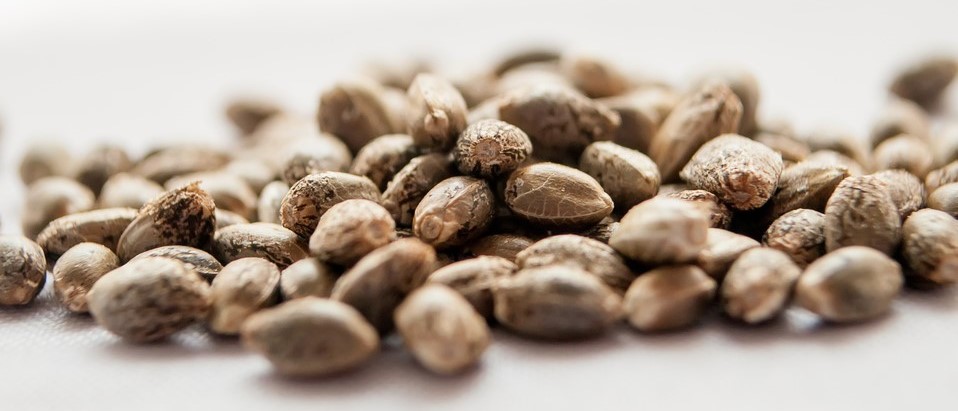
There are two ways to begin a cannabis grow. One is to obtain the seeds you wish to cultivate and germinate them in a growing medium. Growing from seed ensures a genetically unique specimen that will feature traits from both the male and female cultivars used to create the strain. The strain may be heirloom, meaning both the male and female parents were of the same strain, or a hybrid, meaning two different strains were bred together to create a novel strain. One potential downfall of using seeds is that you could end up with a male specimen that won’t produce viable flowers and will pollinate your females if given the chance. A way around this is to purchase feminized seeds, which have a much higher chance of producing female plants.
The second option is to start a grow from clones. A clone is a cutting from a cannabis plant that, when rooted, produces a genetically identical copy of the mother plant. This can be beneficial as it allows growers to replicate desirable traits. However, cloning will also pass down negative traits, such as disease.
TO GROW IN CONTAINERS OR DIRECTLY IN THE GROUND?
Outdoor plants are primarily grown in soil. They can be grown in containers, or raised directly in the ground in raised beds or large fields. There are numerous advantages and disadvantages to each of these approaches, and one method isn’t necessarily better than the other.
Growing in pots is a good approach if you are limited to a small garden, or a garden where most of the soil is covered in cement or stone work. Pots also allow growers to limit the size of their plants to their liking, which is particularly helpful if you’re looking to keep things discreet. The bigger the pot, the bigger the plant, and vice versa.
Growing in pots can also be very convenient if you need to move your plants due to an extreme heat wave, excess rainfall, and cold temperatures that may arrive at the end of the growing season. It’s also easier to ensure potted plants have access to good soil as the surrounding land might have soil that isn’t optimal for plant growth.
The downside of growing cannabis in pots is that they are prone to tipping over if some strong winds sweep through. They also require a bit more attention as they only provide limited water and nutrients.
When it comes to growing cannabis directly in the ground, one massive advantage is, of course, the additional space. The roots are free to dig deeper into the soil, and can therefore obtain larger quantities of nutrients and water. This more complex system also secures plants and makes them more resilient to wind and bad weather. This increase in space allows plants to grow much, much larger. There will also be a richer diversity of microbial life, with mycorrhizal fungi and beneficial bacteria keeping your plant healthy and productive.
The main downside of growing straight in the ground is an inability to move plants during periods of extreme weather.
IT’S TIME TO GET SOME SOIL

Soil is the primary growing medium used outdoors. Soil is essentially broken down organic matter. What was once plant matter died, and was slowly broken down into smaller and smaller molecules by fungi, worms, and microorganisms. Soil can vary massively in quality depending on what was grown on the site beforehand and what kind of pollution or use the soil has been exposed to.
There are 5 different types of soil. It’s important to investigate the quality of the soil in your garden to make sure planting directly in the ground is a viable option. All soil is made up of three ingredients: sand, silt, and clay. It’s the varying ratios of each of these components that determines soil type. Below are the five soil types:
1. Silty—smooth, retains water well, relatively fertile, small particles, poor drainage.
2. Clay—sticky, poor aeration, compact, small particles, holds water well.
3. Sand—gritty, rapid drainage, cannot hold nutrients.
4. Saline soil—found in arid regions, full of salts, features a white surface.
5. Peaty—dark brown/black, loaded with organic matter, acidic.
Your soil will be a combination of most of the types mentioned above. Your native soil may only be a problem if it has been overused in the past and drained of nutrients, or if it has either extremely slow or fast drainage. If the soil in your garden looks good, then go ahead and use it!
If you are choosing to grow in pots or beds, then you can dig up some of the soil in your garden or purchase a potting mix that comes with adequate nutrients for the first few weeks of growth.
If you are growing autoflowering seeds, then you need to consider that they prefer a different type of soil than photoperiodic strains. Autoflowers like aerated and loose soil that isn’t too high in nutrients. You can purchase premixed soil for them or simply create a potting mix of 50% soil and 50% perlite/coco coir.
A WORD ON PH
Remember pH, or “power of hydrogen”, from science class? This logarithmic scale is used to determine the acidity, alkalinity, or neutrality of a particular solution. All soil has a pH value that can be measured using paper test strips or pH probes. Growers should aim to keep their soil's pH within a specific range to keep plants healthy and happy.
The pH scale is a spectrum that ranges from 1 to 14. 1–6 indicate acidic readings, 7 is neutral, and 8–14 indicate alkaline readings. Cannabis thrives in soil that is slightly on the acidic side, and does well between 6.0–7.0. If you find your soil pH is too high, you can add organic matter, sulphur, or peat to resolve the problem. If the pH is too low, try adding lime and wood ash.
HOW TO WATER YOUR CROP CORRECTLY
Water is an essential part of sustaining plant life, but too much of it can be detrimental, and can even end it. Overwatering is a common mistake made by novice growers that results in plant pathologies such as root rot. If growing outdoors, the rain makes it a bit more difficult to accurately gauge how much water your plants are getting. If you live in an area with frequent and heavy rain, then you may need to move potted plants under tarpaulins temporarily and ensure that your garden beds have appropriate drainage. Consider growing in raised beds if you experience these kinds of conditions.
When watering potted plants, the general rule of thumb is to wait until the top inch of soil has become dry before watering again.
Giant cannabis plants grown in the ground will be thirsty for water on an almost daily basis. Different soils hold water at different capacities. Your soil should always have a moist texture, so grab a handful and check if this is the case. If not, then it’s time to water your crop.
YOU’LL NEED TO PROVIDE YOUR PLANTS WITH NUTRIENTS
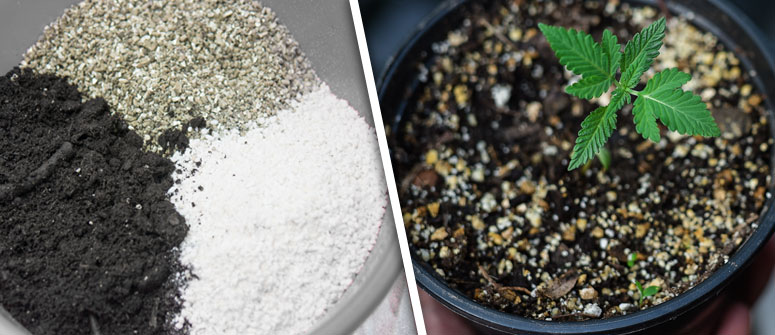
Cannabis plants have specific demands for nutrients during different stages of development. Nutrients are required so plants can carry out vital physiological processes and eventually produce an optimal yield. Too little nutrients will produce deficiencies that can slow growth and damage plants, whereas too much can burn roots and be just as detrimental.
There are three primary nutrients, known as macronutrients, that cannabis requires. These are nitrogen (N), phosphorous (P), and potassium (K). Together, these nutrients are referred to as N-P-K and can be found within most commercial potting mixes. They need to be added in specific ratios during different periods of the growing cycle.
During the vegetative phase, the period before flowering when plants only produce leaves, plants require high levels of nitrogen, medium levels of phosphorus, and high levels of potassium. During flowering, this changes, with plants requiring low levels of nitrogen, medium to high levels of phosphorus, and high levels of potassium. Plants also require micronutrients such as calcium, magnesium, sulphur, iron, manganese, boron, molybdenum, and zinc.
Growers can synthesize their own nutrient formulas, but the easy and basic approach is to purchase premade formulas that are easy to use and have been crafted for specific stages of the grow cycle.
Easy Boost Organic Nutrition by Royal Queen Seeds is a fantastic product to ensure your plants have everything they need to thrive at the beginning of the grow. These pellets will provide 10–12 weeks worth of plant food and are packed with beneficial minerals.
Royal Queen Seeds also provides nutritional formulas for the vegetative and flowering phases, as well as mycorrhizal fungi that will help plants uptake these nutrients efficiently.
Many of these nutrients are suitable for pots and other containers. If you're growing directly in the ground or raised beds, consider making your own compost at home. Toss kitchen scraps and garden debris onto a pile in a ratio of 2 parts brown matter (carbon-rich) to 1 part green matter (nitrogen-rich). Eventually, microorganisms will break down this organic matter into molecules that are available to plants as nutrients. You’ll need to flip the pile every now and then to accelerate the process. Compost heaps will usually produce material that is ready to use after around 6 months.
Compost can also be applied in the form of a tea. Compost tea is known to boost plant growth, and is applied as a foliar spray that nourishes leaves and can stave off pests. Check out this recipe to make your own supply of compost tea.
PROTECT YOUR PLANTS FROM PESTS AND MOLD

One of the largest challenges of growing outdoors is all of the little critters that see your plants as a snack. There are many harmful pest species, from aphids and spider mites to whiteflies and fungus gnats. There are also numerous ways to address pest invasions to prevent them from damaging your plants and potentially reducing yield. Using chemical pesticides is one way of doing it, however, the damage these substances do to environmental and human health isn’t worth the trade-off. Plus, you’re going to end up smoking it.
Biological pest control methods are the better option. These involve techniques such as companion planting, where beneficial plants are cultivated in close proximity to cannabis, helping to lure in beneficial insects and deter pests.
Mold is another potential threat to outdoor cannabis plants, with common forms being bud rot and powdery mildew. Growers can work to prevent these molds by countering stagnant air, cool temperatures, and humid conditions. By planting your crop within the stream of a light breeze, you can help to avoid these molds from taking hold. Some molds can be treated by using foliar sprays, whereas the only way to avoid catastrophe with others is prevention.
FEELING SKETCHED OUT? TRY GUERRILLA GROWING
Too worried to grow cannabis in your garden because of local prohibition? Want to keep your affairs private from others? If this is the case, you should try out guerrilla growing. This involves planting seeds or taking seedlings out into a remote location in the wild. Many guerrilla growers choose to raise their plants in woodlands and fields.
All of the information above also applies to this kind of growing operation, you just need to be a bit more considerate of the location you choose. A good grow spot should have significant light exposure and should be close to a good natural source of water such as a stream or lake. Your location also needs to be far enough away to minimize the chances of somebody stumbling across it, but close enough for you to be able to pay frequent visits to monitor and care for your crop.
Strain selection is also an important factor. Hardy genetics are required due to the increased competition and rougher conditions. Strains such as Northern Light, Quick One, and Royal Jack Automatic are your best friends if you live in a region with less-favorable growing conditions.




